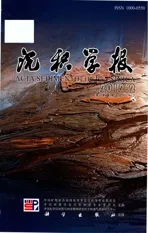江汉盆地ZL钻孔微量元素含量的粒度效应与环境意义①
2012-12-14袁胜元李长安
袁胜元 李长安 邵 磊,3
(1.中国地质大学地球科学学院 武汉 430074;2.中国地质大学生物地质与环境地质教育部重点实验室 武汉 430074; 3.中国地质大学地质过程与矿产资源国家重点实验室 武汉 430074;4.许昌学院城市与环境学院 河南许昌 461000)
江汉盆地ZL钻孔微量元素含量的粒度效应与环境意义①
袁胜元1,2,3,4李长安1邵 磊1,3
(1.中国地质大学地球科学学院 武汉 430074;2.中国地质大学生物地质与环境地质教育部重点实验室 武汉 430074; 3.中国地质大学地质过程与矿产资源国家重点实验室 武汉 430074;4.许昌学院城市与环境学院 河南许昌 461000)
江汉盆地是长江出三峡后第一个大型卸载区,近2.77 Ma以来堆积了近300 m的碎屑沉积物,主要由河流相和湖沼相组成,形成了多个沉积旋回。选择江汉盆地中心位置的ZL钻孔,利用ICP-MS方法展开微量元素组成分析,细粒组分中微量元素含量与各粒组含量相关性并不明显,主要是5~7φ粒级组分表现出微弱的相关性。可见,粒度并非ZL钻孔微量元素丰度的主控因素。钻孔岩心中大部分亲石元素、亲硫元素相对上部陆壳均出现明显富集,亲铁元素总体低于上部陆壳,可能与江汉盆地总体上更多地接受了来自上游而非扬子古陆本地深源物质风化碎屑沉积有关.r、V/Ni和Sr/Ba值的变化则表明江汉盆地在2.6~2.43 Ma B.P。时可能有咸化湖的发育,而在2.1 Ma B.P。左右存在过一段大湖发育期。
江汉盆地 微量元素 粒度效应 古湖泊
1 概述
地壳中化学元素丰度是基础地质、大地构造、成矿、流域环境与地貌演化研究的重要基础,因此,元素在地壳中的分布是地球化学的重要研究内容。在地球化学研究的基础上,形成了化学元素地层学的思想,元素地球化学也成为近代地层学研究的一种重要手段,其理论和方法均在盆地沉积成因研究中得到应用[1]。微量元素研究是元素地球化学的重要分支,尽管沉积物元素组成受多种环境因素影响[2,3],但已有研究表明,微量元素浓度仍然可以提供盆地沉积物物源、风化与沉积过程变化的相关信息[4,5],为重建沉积盆地内古地理及构造历史提供帮助[6~10]。
位于长江中游的江汉盆地因其在长江演化研究中的特殊地位,近年来颇受关注[11~16]。运用地球化学方法进行物源分析、进一步揭示江汉盆地开始接受现代意义长江中上游搬运物质释放时间的研究工作业已展开。但在这些研究中,沉积物微量元素丰度对粒度和物源变化的敏感性是一个重要问题。元素丰度与沉积物粒度的相关性在一些文献中被提及[17~21],来自海洋沉积物方面的研究显示,微量元素具有明显在粘粒组分中富集的趋势[22,23],河流冲积物粒度对微量元素丰度到底有多大程度控制的研究中涉及的微量元素也十分有限[24~26]。
本文以江汉盆地中心300 m深ZL钻孔岩芯为依据,对盆地2.77 Ma以来的第四纪松散沉积的微量元素组成特征进行分析研究,力图确定江汉盆地第四纪以来的松散沉积物粒度对微量元素含量的控制效应,确立江汉盆地沉积物在长江三峡贯通物源示踪研究中的地位和作用。此外,本文对于江汉盆地钻孔沉积物中化学性质较活跃的微量元素对沉积环境的指示意义进行了讨论。
2 样品和方法
2.1 样品来源与测试
江汉盆地位于扬子准地台北缘,属扬子准地台江汉断拗,长江与汉江交汇于此,形成冲积平原。江汉盆地也是长江出三峡后第一个大型卸载盆地,地表组成物质以近代河流冲积物和湖泊淤积物为主,主要为细砂、粉砂及黏土.L钻孔位于江汉盆地中部、湖北省监利县境内。钻孔位置是江汉盆地的沉积中心(图1),第四系厚度大,沉积连续,沉积序列完整清晰,在盆地第四纪沉积中具有良好的代表性。钻孔深300.49 m,取芯率为85%。
江汉盆地沉积物物源区面积广大,岩性复杂.L钻孔沉积物实际上是由很大范围的大陆剥蚀区提供的,而长江和汉水的干流及支流系统则扮演了在广大范围内均匀取样的角色。长江三峡贯通的研究过程中,要求所取样品尽可能反映更大流域范围内沉积物的变化,而细颗粒的沉积物在这方面更能反映广大范围风化产物的均匀混合,同时也能在一定程度上减弱近源碎屑的影响,故研究所用材料主要以ZL钻孔中粉砂及更细的组分为主。
从钻孔岩芯取芯率较高的粉砂层分取47个样品,分别进行粒度和微量元素测定。微量元素样品在高纯水中过250目筛,于无尘环境下自然风干,在中国地质大学(武汉)地质过程与矿产资源国家重点实验室采用美国安捷伦科技公司Agilent 7500a型电感耦合等离子质谱仪(ICP-MS)测定。样品粒度用英国Malvern公司生产的Mastersizer2000激光粒度仪分析测定。
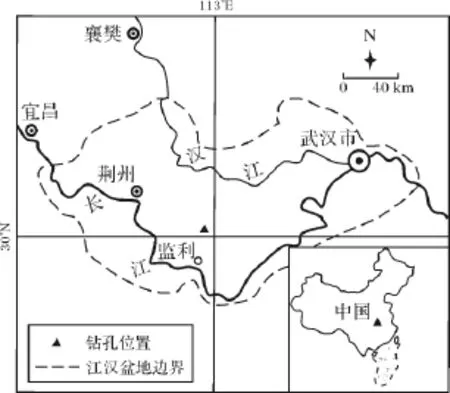
图1 江汉盆地及ZL钻孔位置示意图Fig.1 Location of the Jianghan Basin and the Core ZL
2.2 ZL钻孔岩芯沉积特征与年代序列
2.2.1 钻孔岩芯沉积特征
岩芯以不同颜色的黏土、粉砂质黏土、粉砂、黏土质粉砂、粉细砂、细砂、中砂、中粗砂、粗砂以及砾石等不同岩性的沉积物组成,由下到上显示了几个河-湖相沉积旋回(图2):
(1)300.49~286 m为由绿色到灰绿色粉砂质黏土组成的湖沼相沉积,含褐、灰白杂色斑块,顶部见含植物碎屑的粉砂层。
(2)286~201.93 m为含砾粗砂、细砂夹粉砂质黏土层,偶见黑色淤泥夹层,为河流相沉积。
(3)201.93~162.53 m为浅绿到深灰色的黏土及粉砂质黏土沉积,具明显的水平纹层构造,为湖相沉积。
(4)162.53~132.52 m为砾夹粉砂、黏土,属河流相沉积。
(5)132.52~60.5 m为大量粉砂、黏土夹砾石层的沉积,偶见含古树碎块的细砂层,为河湖交互相沉积。
(6)60.5~0.5 m主要为细砂、粉砂及黏土。底部为一厚约0.5 m的砾石层,砾石砾径多在3 cm左右。砾石层往上为近5 m厚的砾石与粉砂互层。55 m往上粒度渐细,至46 m处发育近0.8 m厚的紫红色黏土层。45~35 m为砾、砂及粉砂混杂沉积层,向上粒度渐细,从23 m往上逐渐出现微层理发育的深灰、青灰色、黄褐色淤泥,中间偶夹一些粉砂或细砂层。粉砂或细砂层顶可见冲刷构造,为漫滩洪水沉积。本段常见带壳类淡水动物壳。0.5 m以上受人类农业活动影响较大。
2.2.2 钻孔岩芯年代序列

图2 钻孔岩性柱及年代序列Fig 2 Lithologic column and chronological sequence
岩芯沉积年代是在磁性地层研究的基础上确定的(图2).runhes正极性世与Matuyama反极性世(B/M)界线,位于深度82 m处.lduvai正极性亚世位于深度154.99~164.37 m之间,其对应的距今年龄为1.77~1.95 Ma;Reunion正极性亚世位于深度178.69~185.07 m之间,其对应的年代为2.14~ 2.15 Ma;对比于国际标准年表,Matuyama负极性世与Gauss正极性世(M/G)的界限(年龄为2.58 Ma),位于深度260 m处。根据沉积速率推算,整个剖面的底部300.49 m深度的磁性年龄为2.77 Ma[15,27]。
3 结果与分析
3.1 沉积物粒度对微量元素丰度的控制
样品采自ZL钻孔粉砂层,进行ICP-MS测试的样品则采用了0.63μm(<5φ)以下的细粒组分,在对这些组分的微量元素含量及粉砂层中小于5~12φ的各粒级组分占样品总量百分比分析的基础上,探讨了细粒组分中碎屑粒度与微量元素含量的相关性。分析表明,23种微量元素的含量与样品中各粒级的相关系数总体较小,相关系数超过0.3的仅占6%, 0.2~0.3的占13%,0.1~0.2的占35%,小于0.1的则占到46%。总的来说,样品微量元素含量受本身粒度组分含量的影响不十分明显。
为明确实验所用的细粒样品粒度组成对微量元素丰度控制的具体情况,对ZL钻孔47个样品的23种微量元素与5~12φ不同粒级(尤登-温德华氏等比制φ值标准)组分在测试样品中所占体积百分比进行了相关性分析(表1)。从表1可以看出,不同元素相对富集的粒径范围不同。多数元素相对集中于5~7φ,例如V、Sc、Cr、Zr、Co、Sr、Ba、Nb、Hf、Ta、Hf、Th、U等,而Li、Rb、Cu、Cs等则相对集中于更细的10 ~12φ组分中,Be、Y、Pb则对5~12φ不同组分没有明显的选择性。
从23种微量元素的丰度与样品平均粒径及各粒级百分含量的相关性分析可以看出,不同元素表现出了向一定粒级集中的微弱倾向,但元素丰度与测试样品各粒径相关性并不突出。这种特征也可以从Sr元素丰度与样品中粉砂和粘粒组分含量的散点图看出(图3),其他各元素情况与Sr相似。散点图中线性相关特征不十分明确。基于上述情况,可以认为ZL钻孔中细粒组分沉积物粒度组成特征并非其微量元素丰度的主控因素,利用细粒组分对江汉盆地钻孔沉积物进行物源变化分析时,其粒度组成不会产生重大影响,物源变化可能是支配江汉盆地沉积物微量元素丰度变化的更重要因素。

表1 粒度组分与微量元素丰度的相关系数Table1 Correlation coefficient between grain size component and trace element abundance
3.2 ZL孔微量元素地球化学分布特征
3.2.1 元素含量随深度的变化
图4表明了ZL钻孔微量元素含量随深度变化的情况。元素丰度平均变异系数为0.23,其中Sr、Zr、Ba、Hf变异系数超过0.5,是含量波动最明显的元素,变化最小的是Y,变异系数只有0.12。对比元素含量变异系数来看,ZL孔岩芯相对上部陆壳明显的富集的元素也是变异系数较大的元素(图4),可能具有一定的物源分析意义。
3.2.2 元素的富集与亏损
从23种微量元素含量经上部陆壳值(UCC)[28]标准化后的模式图可以看出(图4),相对于上部陆壳(UCC),亲石元素中除Be、Ga、Sr、Ba出现亏损,其它大部分如Li、Y、Hf、Ta、Nb等的含量为0~45.83μg/ g,出现明显富集.r含量变化于31~924.38μg/g,在整个岩芯中丰度变化较大,也是相对于上部陆壳最为富集的元素。亲硫元素Cu、Zn含量变化于20.66 ~107.13μg/g,也明显出现富集,而亲铁元素Cr、Co、Ni含量变化于9.86~137.24μg/g,与上部陆壳相当。
明显的Th、Zr、Y富集可能是由于源区岩石中这些元素的含量较多,也可能是江汉盆地沉积物中独居石、锆石等矿物碎屑含量偏高所引起的.b、Ta、Zr、Hf、Th均为高场强元素,其离子半径小,电荷高,离子电位在3以上,难溶于水,具有稳定的化学性质,也是典型的非活动性元素,可作为“原始”物质组成特征的指示剂[29]。地壳岩石中很大一部分Zr、Hf集中在锆石中,其余也多集中于钛铁矿与磁铁矿中,而且,几乎所有的锆矿石都是内生的,具有深源成因[30]。因而这些高场强元素的富集可能反应了流域内深源成因岩类在物源上的贡献.L钻孔中铁族元素与上部陆壳相当,考虑到微量元素测试选用的是63μm以下粒级的组份,而其他研究表明,粗碎屑中除Si、Zr及稀土元素中Ce、Pr、Nd、Sm、Gd、Lu富集外,其它微量元素含量均较低,因此,可以明确ZL孔全岩样品中的铁族元素含量总体应该低于上部陆壳,可见江汉盆地第四纪沉积物直接来源于古老地块的补给是十分有限的[31],其物源中更多的来自于上游河段碎屑的再次沉积,同时也说明,2.77 Ma以来,长江中上游地区风化作用可能并不十分强烈,这一特征也在其他研究中得以证实[32]。
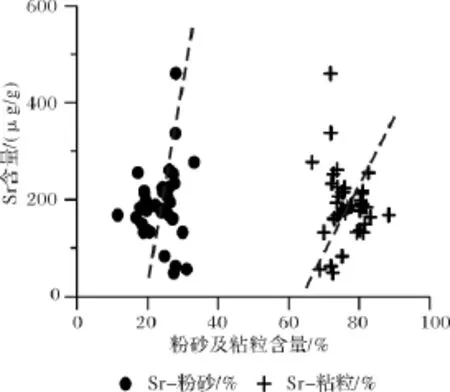
图3 Sr丰度对粉砂及粘粒含量散点图Fig.3 Scatter diagram of Sr element abundance against percentage content of slit and clay
3.3 ZL孔微量元素对古环境变化的响应
3.3.1 元素含量变化与沉积环境
从元素含量变化、岩芯最粗粒径及岩性特征等方面综合来看,ZL孔微量元素含量变化在对古环境变化的响应方面具有如下特征(图5):
(1)Zr、Nb、Hf、Th、U等元素含量升高和Li、Be、Sc、Y、Co、Ni、Cu、Zn、Ga、Rb、Ce、Pb等元素的含量降低反映了较弱的水动力条件,对应了还原性较强的湖泊环境,沉积以青灰色黏土及粉砂质黏土为主,沉积物粒度也较细。这种特征主要表现在2.77~2.43 Ma B.P。和2.0~1.87 Ma B.P。时期。

图4 微量元素含量变异系数及含量UCC标准化模式图Fig.4 Variation coefficient and trace element abundance data normalized against an UCC standard
(2)2.43~2.0 Ma B.P。时期,江汉盆地河流较发育,沉积物中Li、Be、Sc、Y、Co、Ni、Cu、Zn、Ga、Rb、Ce、Pb等元素均出现不同程度的跃升,而反映还原条件的U、Th等的含量则出现明显下降。
(3)1.53~0.58 Ma B.P。沉积物粒径变化与微量元素含量变化的波动较大为这一时期沉积的主要特征,总体上反映了这一时期较为动荡的水环境,可能是对长江中游水文环境重大调整的响应,多数证据认为现代意义整体长江形成于这一阶段,[12,14~16],因此,长江上游地区构造活动通过改变气候与物源的方式影响江汉盆地沉积过程。多数在表生环境中稳定的微量元素对物源变化有较明确的指示,而Sr、Ba、Rb等较易迁移的元素则对气候的变化较为敏感。因此,本段沉积物的微量元素地球化学及粒度特征的变化应该是物源和沉积环境变化的综合反映,至于哪种因素影响更大还有待进一步研究。
(4)0.58 Ma B.P。以来以湖沼相沉积为主,沉积物粒度较细,各微量元素含量波动不大,但Li、Cr、Cu、Ga、Rb、Cs等元素在前一时期的基础上均出现较明显的持续增加趋势,而且就这几种元素来说,这种持续增加的趋势其实可以追溯到1.53 Ma B.P。,而从1.1 Ma B.P。开始变得明确。本段多数微量元素丰度变化并不剧烈,与这一时期冰期-间冰期气候的强烈变化并不对应,可能与江汉盆地是一个混合物源汇集区,物源变化是微量元素组成及含量变化的主控因素有关。
3.3.2 微量元素特征对江汉盆地古湖泊发育的指示
研究表明,Sr的化学性质与Ca比较相似,在风化作用中极易淋失.b与K相似,易富集在风化产物中,而Zr却很稳定,因此,Zr/Rb、Rb/Sr比值常用来表示沉积物粗细颗粒(黏土级)的相对含量及化学风化的强弱,Sr含量低,Rb/Sr、Zr/Rb高,说明化学风化作用较弱;反之则指示较强的化学风化作用[33]./Ni值也与湖盆水体升降及氧化还原程度有密切关系[34].r和Ba的比值可以指示水体盐度,大于1为咸水(海相)介质,小于1为淡水介质[35]。
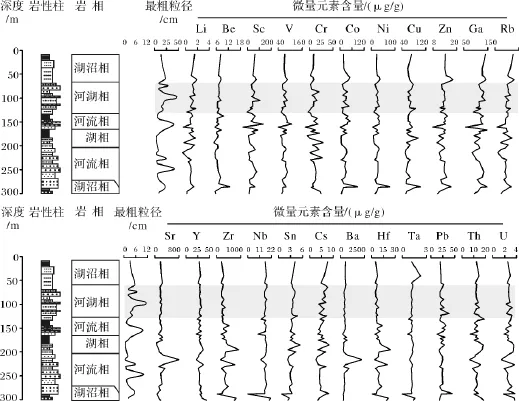
图5 ZL钻孔岩芯微量元素含量分布图Fig.5 Distribution of trace elements in core ZL
ZL孔47个样品Sr/Ba比值绝大多数位于0.14 ~0.67之间,但在深度287 m左右的样品(对应古地磁年龄2.6~2.43 Ma B.P。),其Sr/Ba比值较大,最高达到1.51,这种特征可能指示了一种咸水湖沉积环境。另外,Sr含量在这一时期接近岩芯最低值,说明这一时期化学风化作用较弱,而V/Ni达到最低值则说明这一时期水体处于弱氧化或还原条件(图6)。与此同时,多数亲石元素含量处于钻孔岩芯的较低水平,也反映了较低的陆源碎屑输入。此段沉积物颜色以青灰色为主,与上述微量元素特征相符。因此推测,在大约2.6~2.43 Ma B.P。时,江汉盆地地区气候干旱,周边河流流量减小,导致盆地中心位置有咸化湖发育,同时也引起盆地以外的陆源碎屑输入量降低。钻孔岩芯214 m处(对应古地磁年龄2.1 Ma B.P。),Sr含量达到最高,Sr/Ba比值则相对较低,V/Ni尽管有波动,但总体亦处于较高水平,相当部分亲石元素含量也表现出一个峰值,所有这些特点均表明,这一时期江汉盆地处于一个湿润时期,上游水系供水量充足,盆地有大量陆源碎屑输入,水体处于氧化环境,可能存在一个河流主导下的大湖发育期。
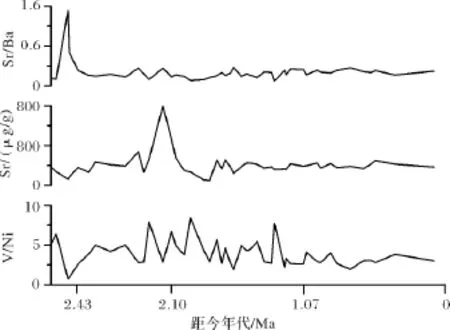
图6 微量元素对古湖泊发育的指示Fig.6 Trace elements as the indicator of paleolake
4 结论与讨论
基于江汉盆地ZL孔岩芯分析,研究地区2.77 Ma B.P。以来的沉积物中微量元素分布具有以下特征:
(1)在63μm以下组分中,亲石元素Li、Y、Hf、Ta、Nb、Zr等含量在整个岩芯中明显富集。亲硫元素Cu、Zn含量变化于20.66~107.13μg/g,也出现明显的富集,而亲铁元素Cr、Co、Ni含量变化于9.86~ 137.24μg/g,与上部陆壳相当。
(2)大多数微量元素与5~7φ粒级组分具有弱相关,而在更细粒级中的富集现象则表现得不十分明显。元素丰度与沉积物粒度的相关性存在不同特征。海洋沉积的研究表明,几乎所有的元素与5φ呈现弱相关[22,23],而汉水沉积物中多数金属元素在细粒中富集[36]。由此可见,微量元素在表生环境中的富集与亏损原因复杂,粒度在不同沉积环境和沉积单元中具有不同的影响力。对江汉盆地而言,物源变化可能是最主要的控制因素,对物源进行深入的分析研究具有实际意义。对于物源变化不大的地区,微量元素丰度及元素比值则可能主要指示了沉积环境、风化程度和构造背景。所以研究一个地区微量元素地球化学特征时,应充分考虑该地区的综合地质背景。
(3)部分在表生环境中相对活跃的元素,其含量变化具有古气候指示意义.r、V/Ni和Sr/Ba值的变化则表明江汉盆地在2.6~2.43 Ma B.P。时可能有咸化湖的发育,而在2.1 Ma B.P。时期,存在过一段大湖发育期。
江汉盆地咸化湖发育时期为早更新世,而据早更新世江汉盆地阳逻组砂砾层孢粉研究,这一时期江汉盆地喜冷、耐干旱植物占优势,针叶、阔叶树种稀少[37],反映了本地区冷干组合的气候类型。由于来水量很少,此时江汉湖盆可能是一个湖水较浅的高盐度湖泊,接近湖泊演化的晚期。这种冷干气候条件下发育的盐湖记录在哈德令盆地尕海钻孔岩芯中也有发现[38]。此外,舒强[39]对苏北盆地兴化钻孔沉积物粒度、磁化率、自然伽马测井曲线、沉积物色度及碳酸盐含量进行了分析,结果显示2.68~2.32 Ma B.P。期间为一个干旱时期,而2.32~2.13 Ma B.P。期间则是一个明显的湿润期,这与本研究的结论基本相符。而长江河口地区1.9 Ma B.P。左右高Sr含量期亦可与ZL钻孔2.1 Ma B.P。左右Sr高含量时期进行对比[40]。
An Zhisheng等[41]根据黄土磁性地层和稳定同位素记录提出东亚季风在3.4 Ma B.P。、2.5 Ma B.P。、1.2 Ma B.P。、0.9 Ma B.P。、0.5 Ma B.P。和0.15 Ma B.P。存在着阶段性变迁的特征,并根据地层学证据认为青藏高原在1.4~1.2 Ma,B.P。0.5 Ma B.P。和0.1 Ma B.P。发生了加速隆升的事件,着重指出1.2 Ma B.P。和0.5 Ma B.P。是东亚夏季风加强的转型点。从图6中可以看出,ZL钻孔Sr、Sr/Ba比较清楚地记录了2.5 Ma B.P。左右气候变冷事件,而V/Ni对1.4~1.2 Ma B.P。青藏高原加速隆升,大量碎屑输入江汉盆地的过程也有所响应。
References)
1 赵振华。微量元素地球化学原理[M]。北京:科学出版社,1997: 2-10[Zhao Zhenhua.The Principles of Trace Element Geochemistry [M].eijing:Science Press,1997:2-10]
2 Nechaev V P,Isphording W C.Heavy-mineral assemblages of continentalmargins as indicators of platetectonic environments[J].ournal of Sedimentary Research,1993,63(6):1110-1117
3 Nesbitt H W,Young G M,McLennan SM,et al.Effects of chemical weathering and sorting on the petrogenesis of siliciclastic sediments, with implications for provenance studies[J].he Journal of Geology, 1996,104(5):525-542
4 Pearce JA,Cann JR.Tectonic setting of basic volcanic rocks determined using trace element analyses[J].arth and Planetary Science letters,1973,19(2):290-300
5 Wood D A,Joron JL,TreuilM.A re-appraisal of the use of trace elements to classify and discriminate betweenmagma series erupted in different tectonic settings[J].arth and Planetary Science Letters,1979, 45(2):326-336
6 Condie K C,Phillip D N J,Conway C M.Geochemical and detrital mode evidence for two source of Early Proterozoic sedimentary rocks from Tonto Basin Supergroup,central Arizona[J].edimentary Geology,1992,77:51-76
7 Singh P,Rajamani V.Geochemistry of the floodplain sediments of the Kaveri River,southern India[J].ournal of Sedimentary Research, 2001,71(1):50
8 Fralick PW,Kronberg B I.Geochemical discrimination of clastic sedimentary rock sources[J].edimentary Geology,1997,113(1-2): 111-124
9 舒强,赵志军,陈晔,等。江苏兴化DS浅孔沉积物地球化学元素与粒度所揭示的古环境意义[J]。地理科学,2009,29(6):923-928[Shu Qiang,Zhao Zhijun,Chen Ye,et al.Palaeoenvironmental significance of geochemistry elements and grain size of DS core sediments in Xinghua,Jiangsu province[J].cientia Geographica Sinica, 2009,29(6):923-928]
10 黄润,朱诚,王升堂。天堂寨泥炭地层的磁化率、Rb/Sr值及其反映的古气候意义[J]。地理科学,2007,27(3):385-389[Huang Run,Zhu Cheng,Wang Shengtang.Magnetic susceptibility and Rb/ Sr ratio of peat stratum in Tiantangzhai and its significance of palaeoclimate[J].cientia Geographica Sinica,2007,27(3):385-389]
11 李长安,张玉芬。中国主要水系贯通和洪灾形成的地学因素分析[J]。大自然探索,1997,16(1):61-65[Li Chang'an,Zhang Yufen.Geoscientific factors analyses on the through cutting of main drainages and the formation of flood damage in China[J].xploration of Nature,1997,16(1):61-65]
12 马永法,李长安,王秋良,等。江汉平原周老镇钻孔砾石统计及其与长江三峡贯通的关系[J]。地质科技情报,2007,26(2):40-44[Ma Yongfa,LiChang'an,Wang Qiuliang,etal.Statistics of gravels from a bore in Zhoulao town,Jianghan plain and its relationship with cut-through of the Yangtze Three Gorges,China[J].eological Science and Technology Information,2007,26(2):40-44]
13 康春国,李长安,邵磊。江汉平原主要河流沉积物重矿物特征与物源区岩性的响应[J]。第四纪研究,2009,29(2):334-342[ Kang Chunguo,LiChang'an,Shao Lei.Heavymineral characteristics of river sediments in Jianghan plain and its response to provenance rock types[J].uaternary Sciences,2009,29(2):334-342]
14 康春国,李长安,王节涛,等。江汉平原沉积物重矿物特征及其对三峡贯通的指示[J]。地球科学:中国地质大学学报,2009,34 (3):419-427[Kang Chunguo,Li Chang'an,Wang Jietao,et al.Heavyminerals characteristics of sediments in Jianghan Plain and its indication to the forming of the Three Gorges[J].arth Science:Journal of China University of Geosciences,2009,34(3):419-427]
15 张玉芬,李长安,王秋良,等。江汉平原沉积物磁学特征及对长江三峡贯通的指示[J]。科学通报,2008,53(5):577-582[Zhang Yufen,Li Chang'an,Wang Qiuliang,etal.Magnetism characteristics of drilling deposits in Jianghan Plain and indication for forming of the Yangtze River Three Gorges[J].hinese Science Bulletin,2008,53 (5):577-582]
16 杨建,李长安,康春国,等。江汉平原沉积物中普通辉石的特征及物源示踪意义[J]。第四纪研究,2009,29(5):1000-1007[Yang Jian,Li Chang'an,Kang Chunguo,et al.Augite in Jianghan Plain sediments and its implication to source tracing[J].uaternary Sciences,2009,29(5):1000-1007]
17 杨守业,李从先.EE示踪沉积物物源研究进展[J]。地球科学进展,1999,14(2):164-167[Yang Shouye,Li Congxian.Research progress in REE tracer for sediment source[J].dvance in Earthsciences,1999,14(2):164-167]
18 杨守业,李从先,Lee C B,等。黄海周边河流的稀土元素地球化学及沉积物物源示踪[J]。科学通报,2003,48(11):1233-1236 [Yang Shouye,Li Congxian,Lee C B,et al.Source tracing of REE geochemistry in rivers around Yellow Sea[J].hinese Science Bulletin,2003,48(11):1233-1236]
19 蓝先洪,王红霞,张志珣,等。南黄海表层沉积物稀土元素分布与物源关系[J]。中国稀土学报,2006,24(6):745-749[Lan Xianhong,Wang Hongxia,Zhang Zhixun,etal.Distributions of rare earth elements and provenance relations in the surface sediments of the South Yellow Sea[J].ournal of the Chinese Rare Earth Society, 2006,24(6):745-749]
20 Dupr B,Gaillardet J,Rousseau D,etal.Major and trace elements of river-bornematerial:the Congo Basin[J].eochimica etCosmochimica Acta,1996,60(8):1301-1321
21 Gaillardet J,Dupre B,Allegre C J.Geochemistry of large river suspended sediments:silicate weathering or crustal recycling[J].eochimica et Cosmochimica Acta,1999,63(23/24):4037-4051
22 杜德文,石学法,孟宪伟,等。黄海沉积物地球化学的粒度效应[J]。海洋科学进展,2003,21(1):78-82[Du Dewen,Shi Xuefa, Meng Xianwei,et al.Geochemical granularity effect of sediment in the Yellow Sea[J].dvances in Marine Science,2003,21(1):78-82]
23 Zhang C,Wang L,Li G,et al.Grain size effect on multi-element concentrations in sediments from the intertidal flats of BohaiBay,China[J].pplied Geochemistry,2002,17(1):59-68
24 戴慧敏,鲍庆忠,杨作升,等。黄河沉积物中稀土元素(REE)组成的粒度效应[J]。第四纪研究,2007,27(5):718-723[Dai Huimin,Bao Qingzhong,Yang Zuosheng,etal.Granularity effectsof rare earth elements(REE)of the Huanghe river sediments[J].uaternary Sciences,2007,27(5):718-723]
25 杨守业,李从先。长江与黄河现代表层沉积物元素组成及其示踪作用[J]。自然科学进展,1999,9(10):930-937[Yang Shouye, Li Congxian.Elemental composition of surface modern sediments in the Yangze River and the Yellow River and its resource tracing[J].rogress in Natural Science,1999,9(10):930-937]
26 王君波,朱立平。藏南沉错钻孔沉积物金属元素分布特征及其与粒度的关系[J]。湖泊科学,2008,20(6):715-722[Wang Junbo, Zhu Liping.Distribution features of elements in core sediments and their relationship with grain size in Lake Chen Co,southern Tibet [J].ournal of Lake Sciences,2008,20(6):715-722]
27 Cande SC,Kent D V.Revised calibration of the geomagnetic polarity timescale for the Late Cretaceous and Cenozoic[J].ournal of Geophysical Research,1995,100(B4):6093-6095
28 Taylor SR,McLennan SM.The Continental Crust:its composition and evolution[M].ew York:Oxford,1985:1-17
29 韩吟文,马振东。地球化学[M]。北京:地质出版社,2003:1-370[Han Yinwen,Ma Zhendong.Geochemistry[M].eijing:Geological Publishing House,2003:1-370]
30 刘英俊,李兆麟,等。元素地球化学[M]。北京:科学出版社, 1984:1-548[Liu Yingjun,Cao Liming,Li Zhaolin,et al.Element Geochemistry[M].eijing:Science Press,1984:1-548]
31 蒋敬业,程建萍,祁士华。应用地球化学[M]。武汉:中国地质大学出版社,200 l:1-251[Jiang Jingye,Cheng Jianping,Qi Shihua.Applied Geochemistry[M].uhan:China University of Geosciences Press,2001:1-251]
32 杨守业。亚洲主要河流的沉积地球化学示踪研究进展[J]。地球科学进展,2006,21(6):648-655[Yang Shouye.Advances in sedimentary geochemistry and tracing applicationsof Asian rivers[J].dvances in Earth Science,2006,21(6):648-655]
33 沈吉,吕厚远,王苏民,等。错鄂孔深钻揭示的青藏高原中部2.8Ma B.P。以来环境演化及其对构造事件响应[J]。中国科学:D辑,2004,34(4):359-366[Ji Shen,Houyuan L,Sumin Wang,et al.A 2.8 Ma record of environmental evolution and tectonic events inferred from the Cuoe core in themiddle of Tibetan Plateau[J].cience in China Series D:Earth Sciences,2004,47(11):1025-1034]
34 Rijks E H.Attribute extraction:An important application in any detailed 3-D interpretation study[J].APG Bulletin,1990,10(7): 11-19
35 李红敬,解习农,颜佳新。扬子地区典型剖面二叠系不同沉积相地球化学特征[J]。地质科技情报,2010,29(2):17-23[Li Hongjing,Xie Xinong,Yan Jiaxin.Geochemical characteristics of different facies of Permian typical sections in the Yangtze region[J].eological Science and Technology Information,2010,29(2):17-23]
36 闫百兴,何岩。汉水沉积物中元素的地球化学特征[J]。地理科学,1996,16(4):312-316[Yan Baixing,He Yan.The geochemical feature of elements in sediment in the Han River[J].cientia Geographica Sinica,1996,16(4):312-316]
37 徐瑞湖。江汉盆地东缘晚第三纪——早更新世的古环境[J]。地域研究与开发,1988,7(3):52-60[Xu Ruihu.Paleoenvironment of the eastern Jianghan Basin from Neogene to early Pleistocene[J].real Research and Development,1988,7(3):52-60]
38 张西营,马海州,韩风清,等。德令哈盆地尕海湖DG03孔岩芯矿物组合与古环境变化[J]。沉积学报,2007,25(5):767-773 [Zhang Xiying,Ma Haizhou,Han Fengqing,et al.Mineral assem-blages and palaeoenvironmental changes of Core DG03 of Gahai Lake in Delingha Basin[J].cta Sedimentologica Sinica,2007,25(5): 767-773]
39 舒强。苏北盆地兴化钻孔近3Ma环境变化记录研究[D]。南京:南京师范大学,2004[Shu Qiang.Study on the changes of palaeoenvironment and palaeoclimate during the past3Ma recorded in Xinghua core at Northern Jiangsu Basin[D].anjing:College of Geography Science Nanjing Normal University,2004]
40 韦桃源,陈中原,魏子新,等。长江河口区第四纪沉积物中的地球化学元素分布特征及其古环境意义[J]。第四纪研究,2006, 26(3):397-406[Wei Taoyuan,Chen Zhongyuan,Wei Zixin,et al.The distribution of geochemical trace elements in the Quaternary sediments of the Changjiang rivermouth and the paleoenvironmental implications[J].uaternary Sciences,2006,26(3):397-406]
41 An Zhisheng,Liu Tungsheng,Lu Yanchou,etal.The longterm paleomonsoon variation recorded by the loess-paleosol sequence in Central China[J].uaternary International,1990,7/8:91-95
Grain-size Dependence and Environment Significance of Trace Elements from ZL Core in the Jianghan Basin
YUAN Sheng-yuan1,2,3,4LIChang-an1SHAO Lei1,3
(1.Faculty of Sciences,China University of Geosciences,W uhan 430074; 2.Key Lab of Biogeology and Environmental Geology of M inistry of Education,China University of Geosciences,Wuhan 430074; 3.Stake Key Laboratory of Geological Processes and M ineral Resources,China University of Geosciences,W uhan 430074; 4.College of Urban Planning&Environment Science,Xuchang University,Xuchang,Henan 461000)
Element content can be affected by the grain size of sediments.Previous studies revealed that elements, content ofwhich can be easily affected the grain size distribution are usually concentrated in fine-grain fractions.The grain size effectmakes itmore complicated to decipher useful information on provenance via the elemental compositions of sediments.Provenance of the late Cenozoic sediments in the Jianghan Basin has been highlighted for a long time.Many provenance indictors have been taken to decipher information on the provenance of the sediments of the Jianghan Basin.Provenance study of the sediments in the Jianghan Basin plays an important role in reconstructing the evolutionary history of the Yangtze River and has been highlighted for a long time.Among these researches,geochemicalmethods have been largely adopted,e.g.the elemental compositions of the sediments.Unfortunately,it is still controversial that how the grain size affect the elemental compositions of the sediments.In this study,we presented the elemental compositions of the late Cenozoic sediments of the Jianghan Basin and tried to decipher some information on the correlation between the elemental compositions and the grain-size effect and the sedimentary environment of the Jianghan Basin.
The correlation between the 23 elements and the grain-size effect revealed that only 6%of the 23 elements show correlation higher than 0.3,while 13%,35%and 46%of the 23 elements show correlation of0.2~0.3,0.1~0.2 and<0.1,respectively.The elements of V,Sc,Cr,Zr,Co,Sr,Ba,Nb,Hf,Ta,Hf,Th,U are relatively concentrated in the grain size fraction of5~7φ,in contrast the elements of Li,Rb,Cu,Cs are concentrated in the grain size fraction of 10~12φ.he contentof Be,Y and Pb are notobviously affected by the grain-size effect.Itmeans that the grain-size effect is not themain factor that affects the elemental compositions of the late Cenozoic sediments of the Jianghan Ba-sin.Based on that,we conclude that the elemental compositions can be effective provenance indicators.The grainsize effect can be ignored when the elemental compositions are used to trace the source of the late Cenozoic sediments of the Jianghan Basin。
The average variation coefficient of the 23 elements is0.23,ofwhich the Sr,Zr,Ba and Hf are themost fluctuant elements while the Y has the lowest variation coefficient.Curiously,the elementswith higher variation coefficients are also enriched compared with the UCC。
The lacustrine sediments with lowest Sr content in the core sediments around the depth of 287 m indicate the weak chemical weathering conditions.The lowest V/Ni ratio indicates the weak oxidizing or reduction conditions.Meanwhile content of the lithophile elements are low throughout the core sediments,indicating less terrigenous input.Besides the color of these sediments is steel gray,which accords wellwith the elemental characteristics.We propose that around 2.6~2.43 Ma BP,the Jianghan Basin was controlled by arid climate.Rivers around the basin werewith smallwater discharge inducing the development of salt lake.All of these factors could result in less terrigenous input.Sediments around the depth of214 m are characterized by highest Sr content.The Sr/Ba ratios are relatively low while the V/Ni ratios are generally high and fluctuant.Most lithophile elements are with peak values of content.All of the evidence indicates that during this period the Jianghan Basin was controlled by humid climate.The water discharge of the riverswas sufficientespecially the upper reaches.Under this condition the basin received large amounts of terrigenous input.As a result of thisweather condition and the river hydrodynamic conditions,the lake in the Jianghan Basin was under oxidizing environment.Based on those evidence,wemade a reasonable assumption that large lake developed under the control of the Yangtze River during this period。
Trace elemental compositions of the sediments revealed thatmost of the lithophile and chalcophile elements are relatively enriched compared to the Upper Continental Crust(UCC).he siderophile elements are depleted compared with the UCC.It probably indicates that themost of the sediments of the Jianghan Basin derived from the upper Yangtze rather than thematerials from the deep earth in the Yangtze block.The lacustrine sediments of the Core Zhoulao around 287m show low-Sr,and V/Ni ratios and high Zr/Sr and Rb/Sr ratios,which indicate that salt lake largely developed in the Jianghan Basin under the cold and dry weather between 2.6~2.43 Ma B.P。.n contrast,freshwater lake developed around 2.1 Ma B.P。.t is consistentwith the late Cenozoic pollen assemblages in the Jianghan Basin, and the sedimentary records in the Subei Basin and Yangtze delta.We conclude that the elemental compositions in the Jianghan Basin might record the global cooling around 2.5 Ma B.P.and the intense uplift of the Tibetan Plateau around 1.4~1.2 Ma B.P。
the Jianghan Basin;trace element;grain-size dependence;palaeolake
袁胜元 男 1971年出生 副教授 博士 第四纪地质学 E-mail:qshengy@163.om
P736.4
A
1000-0550(2012)02-0366-09
①国家自然科学基金项目(批准号:40971008,40771213)、黄土与第四纪地质国家重点实验室开放基金项目(批准号:SKLLQG0908)、地质过程与矿产资源国家重点实验室开放基金项目(批准号:GPMR200908,GPMR200909)、生物地质与环境地质教育部重点实验室开放基金项目(批准号:BGEG1007)。
2010-11-29;收修改稿日期:2011-03-29
